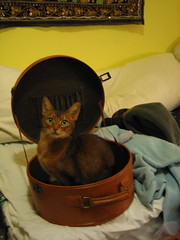Let Them Wear Hats
Last year at our house, we reduced our heating bill by some 20%. I made a joke at my networking meeting about how I was going to write the White House about my new energy policy and call it "Let Them Wear Hats". I was wearing, at the time, my English grandmother's faux fur hat, which has a rakish peak. It was a stylish addition to my outfit.
But hats are only part of the story of our energy conservation. First the heater had to break. It's an old fashion gas heater with two large floor registers coming up on either side of a wall. Essentially it only warms the bedrooms a lot and the living room and kitchen a little. The furnace is right under the floor and the heat coming from the register is intense enough to dry my clothes when I hang them on a rack next to it.
When the repairman came to replace the broken part, he discovered that the programmable thermostat, which had been installed over 10 years ago, would no longer work with the heater. These old heaters are rarely compatible with programmable thermostats, he told us. He suggested replacing the whole system with a modern central heating system that he would be happy to install for us. I was close to throwing a fit. No way would we put in central heating. I was sure that all that ductwork and the warming of distant parts of the house would send our bill sky high. Gas prices had doubled as it was.
But I was more upset about the programmable thermostat. I had fine-tuned the program to trim our heating use. It exuded control and was a sort of clock. In the morning the heater coming on woke the cat up and I knew I would soon have to feed her. When it came on in the early evening it was time to start dinner. The heater brain was taking care of us, part of that automatic house concept that was expected of my American life, just like in the Jetson Family cartoon.
Installing a programmable thermostat was one of the top ten suggestions on every green organization's list. In fact, one of the participants in my environmental leadership course was developing a project to install programmable thermostats in the homes of senior citizens (because they are the most likely to forget to turn off the heat). Was I now to lose my status as an environmentalist? But there was nothing I could do, but accept the retro thermostat and hide our transgression.
The first day, as the temperature dropped at the end of the day, it dawned on me that I didn't have to turn the thermostat on at the usual time. I could just put on more clothes. What a concept! In fact there were a handful of ways to combat the cold. I could close doors to the cold rooms and put on my vintage, Soviet era, military surplus hat. Wow. Wearing it was like having a heater directly on my head. Those Russians know their hats.
"My little Babushka", Catherine greeted me when she came home and saw the hat.
"It's cold in here", she commented. I let her turn on the heat. On days when neither of us was home, the heater didn't come on automatically as it had before and the house just stayed cold while the cat curled up in a pile of blankets. It didn't take long to warm it up and the heat felt luxurious.
This strategy dropped our gas bill considerably. It made me realize where we were as a country. After all, if installing a programmable thermostat was supposed to be the best way to become more energy efficient and here we had cut our bill by 20% by uninstalling one, that means that we are using way more energy than really needed and are not paying attention to energy use at all. Indeed I had clients who left the patio door wide open while the heater was on during the day (for fresh air). The same for the summer when the air condition was on.
In the Bay Area, the wealthy communities like Woodside, Atherton and Hillsborough use 2 to 3 times more energy than other towns with denser populations, but more modest homes. When I heard this statistic I was at such a house, for a fundraiser, looking through a huge expanse of un-insulated plate glass window at a panoramic view of sparsely developed hillside. This is the sort of statistic we greens keep under our hat when fundraising at the homes of wealthy patrons. (This particular house did have an impressive array of solar panels).
At our own, middle class home, we already had double pane windows installed just in the bedrooms and I had salvaged two bags of insulation left over from a construction job, just enough to put an extra layer in the attic over the bedrooms. (This kept those rooms cooler in the summer, too, naturally.) When watching TV in one of the cold rooms, we use a space heater. And at night I make Catherine a hot water bottle because she is cold getting into bed, while I am warm enough under the covers. This allows me to turn off the heat for the night. How old fashion. For Christmas Catherine bought us both knit hats to wear to bed. Now we were really pushing the envelope. I never thought I'd get Catherine to wear a hat indoors.
We had both grown up in warmer climes. She in Southern California and me in the tropics. Being comfortably warm year round in just a t-shirt was the way things should be. Had we not heard Julian Darley, author of "High Noon for Natural Gas" and founder of the Post-Carbon Institute, we would not have given our natural gas use much thought. Julian Darley, an Englishman speaking at the Green Festival, told us how our natural gas resources were diminishing, much like oil resources were diminishing. And it was no good our writing nice letters to corporations asking them to consider being more conscious of our diminishing resources because, and here he did the British equivalent of raising his voice by enunciating emphatically and slowly, "they don't care".
This was the first time I had heard someone actually say this. The prevailing wisdom had been that corporations were filled with people who were caring human beings and that said people could be persuaded to do the right thing all the way to the top levels. And having done the right thing, the company would then shame their competitors into following their example or better lead to innovation that would open up a whole new green business model, bringing forth a brand new green way. Such was the premise of hopeful, green business seminars and environmental groups. After all, Wal-Mart was putting solar panels on its buildings to generate its own power.
And the Environmental Defense Fund, once a radical muckraking outfit, is negotiating with Wal-Mart to cut down the amount of packaging for its Barbie dolls. This would reduce the point of purchase impact of the toy thus the potential of sales, but it would also save them a boatload in paper cost. Now wasn't that a win-win? The problem with these optimistic stories is that they don't follow their own logic to the inevitable conclusion.
Yes, Wal-Mart wants to reduce its costs because it is profit driven like all transnational corporation. And while it's CEO talks earnestly about becoming sustainable, Wal-Mart is still, by design a corporation with stockholders and therefore growth driven. Yes, they could trim their cardboard use, but then, given their expected growth rate they would soon be using more cardboard than ever before, not to mention that Barbie herself is a petroleum-derived product. The whole point of industry is to sell more of everything, every year, which means faster than the natural resources used could possibly be replenished. Julian Darley had one response to such insanity.
"Just. Don't. Give. Them. Your. Money," he said, emphasizing every word as if each one was a command. The phrase took root in our household. Catherine was fond of imitating his clipped English accent and barely contained passion with the line. We turned the heat down and wore our hats. We put on eclectic assortments of sweatshirts and flannel pajamas.
"We're beginning to look like people who live in the sticks in the frozen parts of the country," Catherine commented. Visions of poor farmers in long johns came to mind. Yes, bundling up made us look fat and unfashionable. The point of controlled indoor temperatures is to allow us to wear chic coordinated outfits especially at the office. Of all the buildings I worked in, office buildings were the most overheated.
And hats are pretty alien in modern cultures despite Lady Di having brought back the elaborately decorated picture hat. I could get away with ethnic looking headgear in public with my indeterminate ethnic face. Once a women, sitting next to me at our meditation center, admired my block print African pillbox hat. When I told her about the Russian hat I wore at home, she gave me a worried look and moved away from me.
Recently, an environmentalists at a luncheon, talked about how she adjusted her programmable thermostat to 64° instead of 68°. I told her how uninstalling my programmable thermostat allowed me to reduce my heating bill by 20%. She stared at me for a rather long time. Maybe she thought I was an eco-masochist and I just endure cold like those British boarding school boys who pour buckets of cold water on themselves at dawn. Should I have asked her if she would consider wearing a hat in the house? And if I did would I be overstepping her sense of identity?
Environmental organizations do not ask people to change their fashion sense or consider warming up their body and not the house like the Japanese do. No one is asked to change anything. Just program the thermostat and forget about it. I got a book out from the library on designing and making hats. It shouldn't be hard to make hats trendy again. After all, look how knitting has come back.
On TV a newscaster talks about how shipping natural gas from other sources in the world would soon be a growth industry. But does anyone on TV discuss the coming shortage and what we might do about it? Of course not. That would disturb the market for natural gas. Not to mention that shipping gas means heavy steel canisters on trucks burning diminishing supplies of diesel fuel. When it does come down to shortages, the administration won't even have the balls to say, "Let them wear hats".
A contractor hired by our meditation center to put a heater into a cold room in the building advised against a gas heater because he, too, doubted the continuing supply of natural gas. We opted for electric. I had also heard that shortages of natural gas would cause the pressure to drop in our pipelines. Too little pressure in pipes going to homes would mean that pilot lights would go out, which would then lead to potential fires from leaking gas. An efficient, low emission wood stove was sounding better all the time. I put it on my list.
Julian Darley's solution is to re-localize communities, build a parallel universe that is self-sufficient and supplies itself with local products or goes without. His re-localization campaign had inspired the town of Willits and others to start developing local sources for power, locally grown foods, locally made products. Hmmm. How about hats of distinctive regional design?
Also posted at energy bulletin






